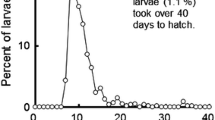Abstract
A laboratory study of preimaginal development, adult longevity and fecundity ofEncarsia inaron (Walker) was conducted. Preimaginal developmental times varied with temperature, from 55–60 d at 15±1°C to 14–17 d at 30±1°C. No development took place at 10°C, which was approximately the developmental minimum estimated from regression analysis of developmental rates vs. temperature in the range 15–30°C. Development was slowed and survival was reduced at 32°C. Females lived an average of 18.6 days and laid a average of 159 eggs/female at 25°C. At 25°C, average preimaginal survival was 59.3%, and the sex ratio was 73.5% female. The net reproductive rate (R0) forE. inaron calculated from these studies was 69.3, while the intrinsic rate of natural increase was 0.1686 individuals per individual per day. Oviposition was concentrated slightly in third instar nymphs of the host.
Résumé
Une étude a été menée en laboratoire sur le développement préimaginal, la longévité et la fécondité des adultes d'Encarsia inaron (Walker). La durée de développement préimaginal varie avec la température, entre 55 à 60 jours à 15±1°C et 14 à 17 jours à 30±1°C. Il n'y a pas de développement à 10°C, température qui correspond approximativement au seuil estimé à partir de la droite de régression de la vitesse de développement par rapport à la température dans l'intervalle 15–30°C. Le développement est ralenti et la survie réduite à 32°C. En moyenne, les femelles vivent 18,6 jours et pondent 159 œufs à 25°C. A cette même température, la survie préimaginale est en moyenne de 59,3% et la sex-ratio de 73,5% de femelles. Le taux net de reproduction R0 deE. inaron calculé à partir de ces études est de 69,3%, alors que le taux intrinsèque d'accroissement naturel est de 0,169 individus par individu et par jour. En ce qui concerne l'oviposition, une légère préférence est montrée pour le 3e stade larvaire de l'hôte.
Similar content being viewed by others
References
Arakawa, R. — 1982. Reproductive capacity and amount of host-feeding ofEncarsia formosa Gahan (Hymenoptera: Aphelinidae). —Z. angew. Ent., 93, 175–182.
Avilla, J. A. &Copland, M. J. W. — 1987. Effects of host stage on the development of the facultative autoparasitoidEncarsia tricolor (Hymenoptera: Aphelinidae). —Ann. appl. Biol., 110, 381–389.
Bellows, T. S., Paine, T. D., Gould, J. R., Bezark, L. G., Ball, J. C., Bentley, W., Coviello, R., Downer, J., Elam, P., Flaherty, D., Goureia, P., Koehler, K., Molinar, R., O'Connell, N., Perry, E., &Vogel, G. — 1992a. Biological control of ash whitefly: a success in progress. —Calif. Agric., 46(1), 24.
Bellows, T. S. Jr., Van Driesche, R. G., Elkinton, J. S. — 1992b. Life-table construction and analysis in the evaluation of natural enemies. —Annu. Rev. Entomol., 37, 587–614.
Burnett, T. — 1949. The effect of temperature on an insect host-parasite system. —Ecology, 30, 431–438.
Gerling, D. — 1966. Studies with whitefly parasites of southern California. I.Encarsia pergandiella Howard (Hymenoptera: Aphelinidae). —Can. Entomol., 98, 707–724.
Gerling, D. — 1990. Natural enemies of whiteflies: predators and parasitoids. pp. 147–185. In: Whiteflies: their bionomics, pest status and management. (Gerling, D., ed) —Intercept, Andover.
Gerling, D. &Foltyn, S. — 1987. Development and host preference ofEncarsia lutea (Masi) and interspecific host discrimination withEretmocerus mundus (Mercet) (Hymenoptera, Aphelinidae) parasitoids ofBemisia tabaci (Gennadius) (Homoptera: Aleyrodidae). —J. Appl. Ent., 103, 425–433.
Gerling, D., Spivak, D. &Vinson, B. — 1987. Life history and host discrimination ofEncarsia deserti (Hymenoptera: Aphelinidae), a parasitoid ofBemisia tabaci (Homoptera: Aleyrodidae). —Ann. Entomol. Soc. Am., 80, 224–229.
Gould, J. R., Bellows, T. S. &Paine, T. D. — 1992a. Population dynamics ofSiphoninus phillyreae in California in the presence and absence of a parasitoid,Encarsia partenopea. —Ecol. Entomol., 17, 127–134.
Gould, J. R., Bellows, T. S. &Paine, T. D. — 1992b. Evaluation of biological control ofSiphoninus phillyreae (Haliday) by the parasitoidEncarsia partenopea. —Biol. Cont., 2, 257–265.
Leddy, P., Paine, T. D., &Bellows, T. S. Jr. — 1995. Biology ofSiphoninus phillyreae (Haliday) (Homoptera: Aleyrodiadae) and its relationship to temperature. —Environ. Entomol., 27, 380.
Madueke, E.-D. N. &Coaker, T. H. — 1984. Temperature requirements of the whiteflyTrialeurodes vaporariorum (Homoptera: Aleyrodidae) and its parasitoidEncarsia formosa (Hymenoptera: Aphelinidae). —Entomol. Gener., 9(3), 149–154.
Mazzone, P. — 1983. Contributi alla conoscenza morfo-biologica degli Afelinidi. 1. Osservazioni sugli stadi preimmaginali e sulla biologia diEncarsia partenopea Masi. —Boll. Lab. Entomol. Agrar. F. Silvestri Portici, 40.
Nechols, J. R. &Tauber, M. J. — 1977. Age-specific interaction between the greenhouse whitefly andEncarsia formosa: Influence of host on the parasite's oviposition and development. —Environ. Entomol., 6, 143–149.
Nell, H. W., Sevenster-van der Lelie, L. A., Woets, J. &van Lenteren, J. C. — 1976. The parasite host relationship betweenEncarsia formosa (Hymenoptera: Aphelinidae) andTrialeurodes vaporariorum (Homoptera: Aleyrodidae). II. Selection of host stages for oviposition and feeding by the parasite. —Z. angew. Ent., 81, 372–376.
Osborne, L. S. — 1982. Temperature-dependent development of greenhouse whitefly and its parasiteEncarsia formosa. —Environ. Entomol., 11, 483–485.
Polaszek, A., Evans, G. A., &Bennett, F. D. — 1992.Encarsia parasitoids ofBemisia tabaci (Hymenoptera: Aphelinidae, Homoptera: Aleyrodidae): a preliminary guide to identification. —Bull. Ent. Res., 82, 375–392.
Priesner, H. &Hosney, M. — 1932. Contributions to a knowledge of the whiteflies (Aleurodidae) of Egypt (I.). —Tech. Sci. Ser., Bull. no. 121, Government Press, Cairo.
Southwood, T. R. E. — 1978. Ecological methods. —Chapman & Hall, London. 524 pp.
Thompson, C. R. — 1985. Temperatures lethal for citrus backfly parasites,Encarsia opulenta andE. smithi (Hym.: Aphelinidae). —Entomophaga 30, 87–91.
Vet, L. E. M. &van Lenteren, J. C. — 1981. The parasite-host relationship betweenEncarsia formosa Gah (Hymenoptera: Aphelinidae) andTrialeurodes vaporariorum (Westw.) (Homoptera: Aleyrodidae). X. A comparison of threeEncarsia spp. and oneEretmocerus sp. to estimate their potentialities in controlling whitefly on tomatoes in greenhouses with a low temperature regime. —Z. angew. Ent., 91, 327–348.
Viggiani, G. — 1984. Bionomics of the Aphelinidae. —Ann. Rev. Entomol., 29, 257–276.
Author information
Authors and Affiliations
Rights and permissions
About this article
Cite this article
Gould, J.R., Bellows, T.S. & Paine, T.R. Preimaginal development, adult longevity and fecundity ofEncarsia inaron (Hym.: Aphelinidae) parasitizingSiphoninus phillyreae (Hom.: Aleyrodidae) in California. Entomophaga 40, 55–68 (1995). https://doi.org/10.1007/BF02372681
Received:
Accepted:
Issue Date:
DOI: https://doi.org/10.1007/BF02372681




